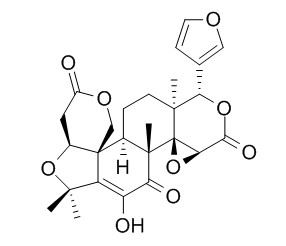Evodol
Evodol may as an anti-inflammatory agent or lead compound, it shows inhibitory activity on nitric oxide (NO) production in lipopolysaccharide -activated RAW264.7 macrophages. Evodol and limonin possess larvicidal activity against the Asian tiger mosquitoes with LC50 values of 52.22 and 32.43 ug/ml, respectively.
Inquire / Order:
manager@chemfaces.com
Technical Inquiries:
service@chemfaces.com
Tel:
+86-27-84237783
Fax:
+86-27-84254680
Address:
1 Building, No. 83, CheCheng Rd., Wuhan Economic and Technological Development Zone, Wuhan, Hubei 430056, PRC
Providing storage is as stated on the product vial and the vial is kept tightly sealed, the product can be stored for up to
24 months(2-8C).
Wherever possible, you should prepare and use solutions on the same day. However, if you need to make up stock solutions in advance, we recommend that you store the solution as aliquots in tightly sealed vials at -20C. Generally, these will be useable for up to two weeks. Before use, and prior to opening the vial we recommend that you allow your product to equilibrate to room temperature for at least 1 hour.
Need more advice on solubility, usage and handling? Please email to: service@chemfaces.com
The packaging of the product may have turned upside down during transportation, resulting in the natural compounds adhering to the neck or cap of the vial. take the vial out of its packaging and gently shake to let the compounds fall to the bottom of the vial. for liquid products, centrifuge at 200-500 RPM to gather the liquid at the bottom of the vial. try to avoid loss or contamination during handling.
Biorxiv2019, 10.1101
Adv. Anim. Vet. Sci.2024, 12(5):986-993.
Pharm Biol.2017, 55(1):360-366
Molecules2022, 27(14):4601
Neuropharmacology.2018, 131:68-82
Exp Mol Med.2020, 52(4):629-642.
The Korea Journal of Herbology2016, 29-35
Chem Biodivers.2023, 20(12):e202301461.
J Nutr Biochem.2022, 107:109064.
Separations2023, 10(11), 567;
Related and Featured Products
J Asian Nat Prod Res. 2013;15(10):1130-8.
Limonoid constituents of Euodia rutaecarpa var. bodinieri and their inhibition on NO production in lipopolysaccharide-activated RAW264.7 macrophages.[Pubmed:
23869424 ]
METHODS AND RESULTS:
A new limonoid compound, named evorubodinin (1), was isolated from the dried and nearly ripe fruits of Euodia rutaecarpa (Juss.) Benth. var. bodinieri (Dode) Huang (family Rutaceae), together with two known limonoid compounds, limonin (2) and evolimorutanin (3). The chemical structure of 1 was elucidated by spectroscopic method and single-crystal X-ray diffraction. The inhibitory effects of the isolated compounds 1-3 and the structurally related compounds Evodol (4), shihulimonin A1 (5), evodirutaenin (6), 12α-hydroxyrutaevin (7), and rutaevin (8) on nitric oxide (NO) production in lipopolysaccharide-activated RAW264.7 macrophages were also assayed.
CONCLUSIONS:
All compounds 1-8 showed the inhibitory activity, in which both 7 and 8 with the uncommon 5β-H configuration more efficiently inhibited NO production. The results provided valuable information for further investigation of compounds 1-8 as anti-inflammatory agents or lead compounds.
Parasitol Res. 2012 Sep;111(3):991-6.
Mosquito larvicidal activity of alkaloids and limonoids derived from Evodia rutaecarpa unripe fruits against Aedes albopictus (Diptera: Culicidae).[Pubmed:
22526296]
METHODS AND RESULTS:
Bioactivity-directed chromatographic separation of chloroform extract on repeated silica gel columns led to the isolation of three alkaloids (evodiamine, rutaecarpine, and wuchuyuamide I) and two limonoids (Evodol and limonin). The structures of the constituent compounds were elucidated based on high-resolution electron impact mass spectrometry and nuclear magnetic resonance. Evodiamine, rutaecarpine, and wuchuyuamide I exhibited strong larvicidal activity against the early fourth instar larvae of A. albopictus with LC(50) values of 12.51, 17.02, and 26.16 μg/ml, respectively. Limonin and Evodol also possessed larvicidal activity against the Asian tiger mosquitoes with LC(50) values of 32.43 and 52.22 μg/ml, respectively, while the ethanol extract had a LC(50) value of 43.21 μg/ml.
CONCLUSIONS:
The results indicated that the ethanol extract of E. rutaecarpa and the five isolated constituents have a good potential as a source for natural larvicides.



